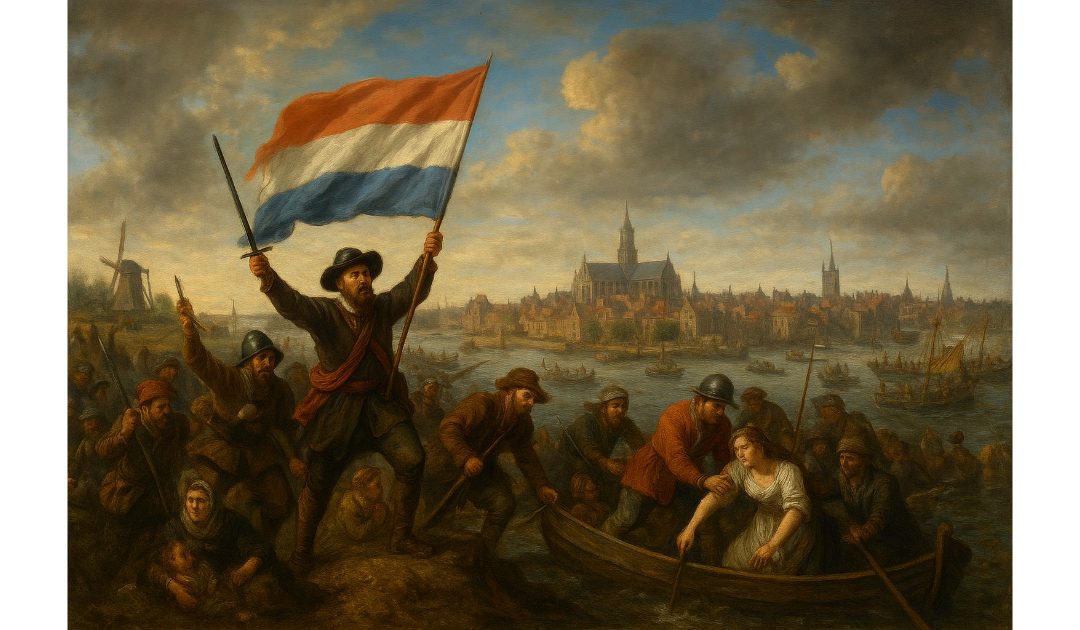My pick for today’s historical event is the Siege of Leiden, which was a pivotal event in the Eighty Years’ War. Sir Anthony Standen was an Elizabethan Spy and was spying for Sir Francis Walsingham in Flanders at the time. In The Spy who Sank the Armada, the first book in the Sir Anthony Standen Adventures, Anthony serves with the Sea Beggars, who play a key role in relieving the siege.
This conflict became a symbol of Dutch resilience against Spanish domination and significantly influenced the emergence of the Dutch Republic. The siege highlighted the strategic interplay of military tactics, political resolve, and the determination of the Leiden citizens.
Background to the Conflict
The Eighty Years’ War commenced in 1568 as the Dutch provinces, led by William of Orange, revolted against Spanish rule under King Philip II. The imposition of heavy taxes, suppression of Protestantism, and the overarching authoritarian regime fuelled discontent. Leiden, a prosperous city in South Holland, became a focal point due to its strategic location and stronghold significance.
The First Siege (October 1573 – March 1574)
The Spanish forces, under Francisco de Valdez, initiated the first siege in October 1573. The city, fortified but not entirely prepared for prolonged isolation, faced immediate challenges. The defenders, including local militias and citizens, showed formidable resistance. However, starvation and disease took a heavy toll.
William of Orange, leading the revolt, managed to send some reinforcements and supplies, alleviating Leiden’s dire situation temporarily. As the Spanish army faced its logistical hurdles and external military pressures, they lifted the siege in March 1574, offering Leiden a brief respite.
The Second Siege (May – October 1574)
Determined to subdue Leiden, Valdez regrouped and launched a second siege in May 1574. This time, the Spanish fortified their positions with better planning, cutting off all supplies and escape routes. Leiden’s defenders, under the leadership of Mayor Pieter Adriaanszoon van der Werff, braced for a grueling blockade.
Conditions deteriorated rapidly. Food became scarce, and famine ensued. The population resorted to eating horses, dogs, and even roots. Disease, particularly the plague, spread, exacerbating the suffering. Despite the extreme hardship, the citizens refused to surrender, driven by a mix of patriotic fervour and fear of brutal Spanish reprisals.
The Relief Effort
William of Orange, recovering from illness, orchestrated an innovative relief plan. Recognising the unique geography of the Low Countries, he decided to breach the dykes and flood the region surrounding Leiden. This bold move would allow the ‘Sea Beggars’, a fleet of rebel ships, to sail overland and reach the beleaguered city.
The flooding progressed slowly due to unfavourable winds and tides. The Sea Beggars, under Admiral Louis Boisot, battled not just the Spanish but also the challenging conditions. As water levels rose, the Spanish found their positions untenable. Yet, they held on, hoping Leiden would capitulate before relief could arrive.
The Climactic Victory
On the 3rd of October, 1574, after months of suffering, the Sea Beggars broke through the final Spanish defences. They entered Leiden, bringing much-needed food and supplies. The Spanish, demoralised and weakened, retreated hastily. The city was saved, marking a monumental victory for the Dutch revolt.
Aftermath and Legacy
The relief of Leiden had far-reaching consequences. To honour the city’s resilience, William of Orange established Leiden University in 1575, a gesture recognising both the city’s sacrifice and the importance of education. The university remains one of the Netherlands’ most prestigious institutions.
Leiden’s victory inspired other cities and fortified the resolve of the Dutch provinces. The siege showcased the effectiveness of using the region’s water management infrastructure as a defensive tool, a tactic that would be employed in future conflicts.
The annual commemoration of Leiden’s relief, celebrated every 3rd of October, reflects the enduring legacy of the event. The festivities, including the traditional dish of hutspot (a stew reportedly found in the abandoned Spanish camp), connect present-day Leideners with their historical past.

